Weapons of Japan - Swords
The sword is the weapon of murder. Kenjutsu is the art of killing. You can embellish it, you can ask for high goals ... Reality is a reality. M / f «Ruruoni Kenshin»
This article is devoted to the weapons of the Land of the Rising Sun.
We begin, perhaps, with the embodiment of the soul of a samurai - Japanese swords.
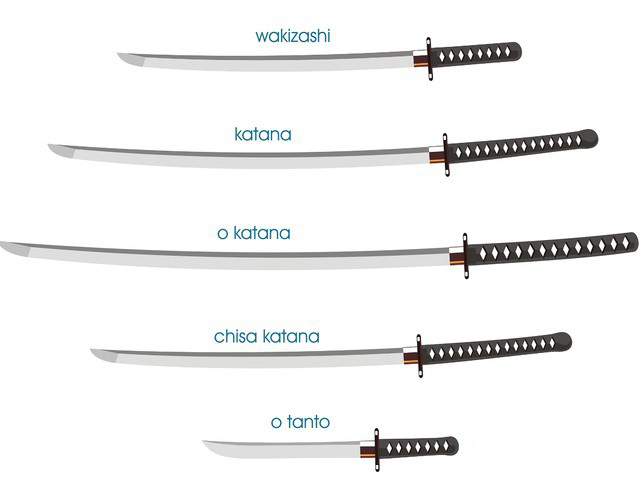
Terminology
Japanese swords are divided into three categories - in size :
- Large swords (o-dati or daito) - blades more than two shaku (60 cm). The most famous representatives of these swords are the katana, tsurugi, tati and their varieties, as well as no-dates.
- Small swords (shoto or co-date) are blades from one (30 cm) long to two shaku. This group includes such swords as wakidzashi, kosi-gatan, tisai-gatan ...
- Daggers are blades with a length of less than one shaku. First of all, it is tanto and aikuti, as well as other types of "pocket swords".
The very terminology itself is so confused that it is not easy for experts to understand it, besides, the Japanese language is extremely rich in definitions. Often, the same detail in different swords is called differently (even if differences in them should be sought with a microscope).

Essential elements:
- Tsuba - Garda. In contrast to European swords, in Japanese garda was mainly decorative function and often made very fragile (in some cases - and at all delicate);
- Tsuka - the hilt;
- Makugi - a solid pin, with which the blade was attached to the handle;
- Manuka - ornaments on the sword hilt;
- Asya - rings on the scabbard, for which they were hung on the belt.
Japanese sword and its development
Ancient swords (dzyokoto)
About the early history of Japan is known very little. The population of the country at that time was a real soup of many tribes, at different times arrived on the islands, including Altaic and Austronesian settlers. Gradually, the tribes formed clan states under the leadership of the invading Yamato clan. From this moment the history of the Japanese empire begins - henceforth the family of Jammu from the Yamato clan is declared imperial, - and about the same time the first invasion of Japan to Korea took place under the leadership of the legendary Empress Dzintu. It was the 4th century AD. It is this time that the first descriptions of the equipment of Japanese soldiers dated by Chinese historians during the Sui dynasty are dated. According to the records, "bows, arrows with iron and bone tips, swords, crossbows, long and short spears, armor of lacquered skins constitute their military equipment."
The ancient Japanese swords were not at all like the refined blades of the later period - crude and effective, they were quite in line with the then technical level.
Judging by the excavations, the first - around the 3rd-4th century AD - a sword known as the Chokuto fell into the hands of a Japanese warrior. It is not known exactly whether he appeared in Japan or was exported from neighboring Korea and China; It is believed that in Japan blades were copied from foreign samples. Initially, the swords were cast from bronze, then they were forged from a single piece of low-quality (the other was not then) steel with a rather primitive technology. Most of the tekuto had a relatively narrow blade with a slight internal curvature, which made them somewhat similar to the ancient Greek kopis or mahayr. Garda, as a rule, was absent, and the pommel was in the form of a ring. Like the western peers, the tekuto was intended primarily for piercing strokes. The most ancient of the known Tekuto is a sword of the Sukanto-no-Tati type.
In the 6th century, a double-edged straight sword approximately 60-70 cm in length (although there were samples about 220 cm long!), Known as ken or tsurugi, comes to Japan together with Zen Buddhism. These weapons performed mostly ritual functions and in battles almost did not participate.

It's interesting: according to myths, the sword, among other things, gave people Amaterasu (the goddess of the sun, in combination - the head of the Shinto pantheon). She sent her grandson from heaven to bring order to people, for which he provided him with a magic jasper, a mirror - and a sword. The sword was obtained by her brother, the god of hurricanes Susanoo no Mikato, from the tail of the eight-headed and eight-tail dragon of Yamato-no-Orochi, and at first was called Ame-no-morakumo-no-hoken (Heavenly precious sword of gathering clouds), and later Kusanagi- But-tsurugi (Sword mowing the grass). To this day, these three subjects remain regalia of the imperial family of Japan.
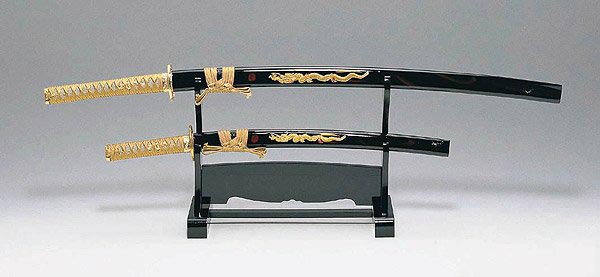
The history of Japan goes on as usual. In parallel with swords in Japan, armor develops, writing appears. The Imperial Court is half submerged in decadence, while the military class that governs the clans is constantly fighting and gaining strength. Do not stop the senseless and hopeless war in Korea. From China, horses are brought in - and hand shields disappear from use. The main symbol of the samurai of that time is the bow and horse, but the sword's elevation is just around the corner ... And so it happened! Somewhere between 697 and 708 years (if you believe the legends), the famous blacksmith Amakuni invents the prototype of the katana, dividing the Tsurugi's sword along the line ...
Old swords (Koto)
The period of the so-called "Old Swords" lasted from 795 to 1596 AD. Some time passed after the blacksmith Amakuni made his experiment, and the famous curved blades appeared. At first, while the production technology was not worked out, the crooked sword was used on a par with the straight, but in the end remained the most worthy.
In the 10th century the "samurai set" of equipment was finally formed. Armor, tachi's sword, sati-gatan's sword-companion and Yumi's bow. Approximately at the same time, the first "classical armor of the samurai" appeared-o-yoy. Poorer samurai infantrymen wore light armor to do-maru, much less constrained movements. Since the Tati of that time was too long for the infantry, the Uchi-gatan sword that replaced him was replaced by a sword upward.
In the thirteenth century, Japan was faced with a difficult test, which made many changes both in tactics and in the equipment of soldiers. The hordes of the Mongol Khan Khubilai, who had already conquered China, twice landed on the shores of the Land of the Rising Sun, despite typhoons of kamikaze, both of which destroyed most of the Khan's fleet. At that time, the Mongols were one of the strongest armies in the world - the famous short Mongolian bows, the cavalry tactics worked out to the ideal, light equipment and powdered "toys" in China ... However, Japan, with miracles of heroism, stood it. And I made conclusions, embodied including in swords.
During the prolonged war between the southern and northern imperial dynasties of the Nambokuto period (1336-1392), in connection with the growth of the role of infantry units, another type of Tati appears - the field sword no-date. At the same time, samurai in a civil dress begin to wear two uchi-gatan swords, since the taty is excessively cumbersome and uncomfortable in the house or on city streets, besides it is very difficult to snatch quickly.
Gradually, o-yoi armor goes out of use, and even the wealthy samurai begin to prefer pre-maru - previously richly adorned them in accordance with the status. Then a completely new armor of haramaki appears. Lack of samurai led to the emergence of a new kind of troops, known as ashigaru and in fact, by somehow trained peasant militia. For them, inexpensive and technologically developed haraate breastplates, which protected only the stomach, and the dzingas helmets (thin helmets resembling the shape of straw hats) were immediately invented.
Finally, at the end of the 15th century, the Tati finally comes out of widespread use, and the increasingly acclaimed uti-gathana is divided into two different types of sword - the legendary katana (blade more than 60 cm) and slightly less legendary wakizashi (30 to 60 cm). Both swords are worn just like uti-gatana: behind the belt, the blade is up.
This remarkable event was followed by another, no less significant. Tired of the ongoing internal conflicts, the long-suffering Japan plunged into the Sengoku Jidai period, also known as the "Age of Warring Provinces." Throughout the country there is no place left where there are no clashes between the clans; Martial arts schools reach their peak - students do not lack practical lessons, and weak schools quickly disappear, unable to withstand stronger ones.
The growing need for weapons led to the division of swords into two categories - high-quality tumon-uchi ("custom-made swords") and low-quality kadzu-uchi ("mass swords"), or tobacco ghatan ("swords in bundles").
In 1543, an event occurred that completely changed the nature of the war in Japan. Portuguese traders brought firearms - arquebus, called teppo. They were very inaccurate and slow, but armor pierced well. In the battle of Nagasino in 1573, the daimyo (prince) Oda Nabunaga shot from the rifles the cavalry of the Takeda clan, considered the best in Japan! Samurai did not even get to the shooters ...
Consider the swords closer
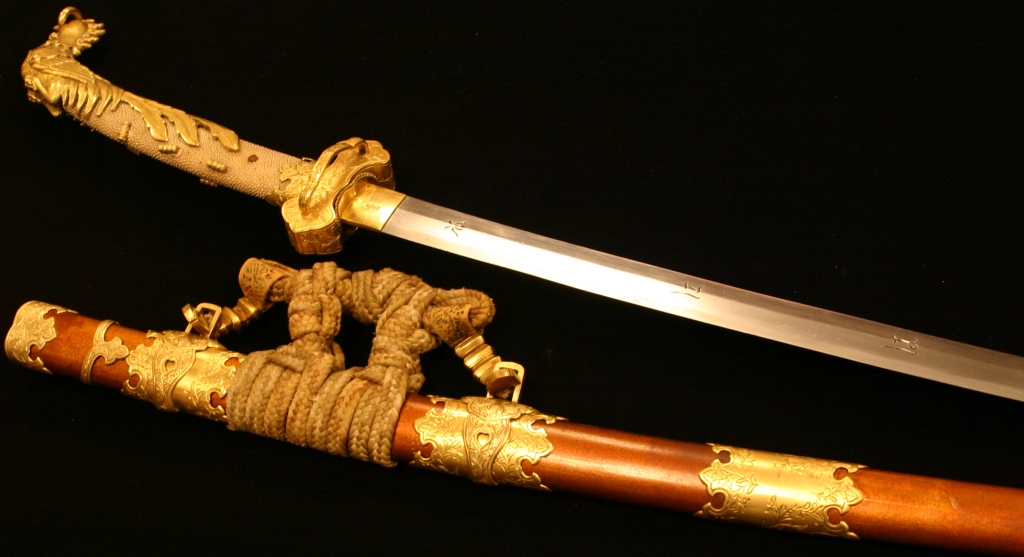
First of all, of course, it is worth mentioning a taty - a curved sword , designed for equestrian combat. At first, his blade was unusually long (up to 120 cm) and narrow, but the Mongol invasions pointed to the excess fragility of the blade, which resulted in such dimensions, which quickly led to the spoilage of the sword without the possibility of repair. Tati was worn on a belt, fastened with cords for two rings on a scabbard. The taty's arm was fitted under a one-and-a-half grip.
It was the Tati who first tested the famous multi-layer forging technology. It consisted in the following: two pieces of metal were taken-solid steel and soft iron-and were tied together until the state of actual adhesion. The resulting double sheet was folded in half - and again shackled. Thus it was possible to obtain a blank with hundreds (and some sources speak of thousands) of alternating layers, which gave the blades incredible strength and endurance for that time. Then the blade was coated with clay and sent to the furnace for quenching. The clay layer was uneven and vanished at the very edge of the blade, which made the blade much harder than the rest of the sword. It is because of this unevenness that the blades are curved.
Yes, initially blades were forged straight. It is likely that curved swords were invented accidentally - during experiments to improve swords. Later it turned out that a curved blade is much better than a straight blade, and it started ...
It's interesting: the wavy pattern on the blade is also a consequence of quenching with the use of clay.
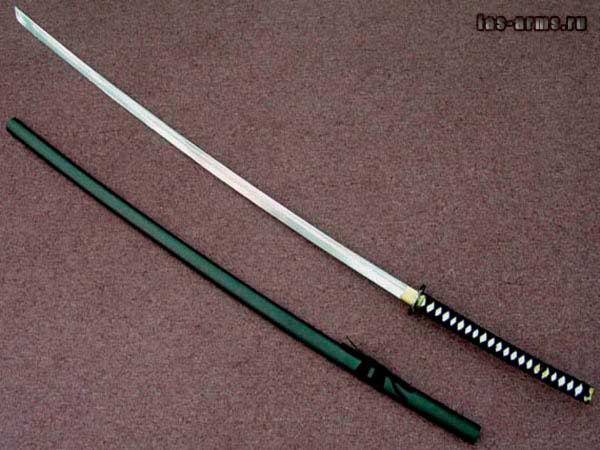
Field sword no-date (also known as the pseudo-Japanese nickname of daikatan) appeared as a consequence of the increase in the value of infantry. This two-handed sword (a total length of up to two meters!) Was worn on the shoulder or behind the back and was used solely by infantrymen; His main purpose was wide sweeping blows, including at the foot level. Infantrymen, armed no-dates, usually went into battle in light armor (up to the fact that there was only one loincloth), since this sword made quite high demands on the dexterity and mobility of the owner. As a rule, no-dates were armed with low-ranking warriors - poor samurai and, later, ashigaru.

Kosi-gatan can be considered in some way the ancestor of the famous wakizashi. He was worn with a blade tucked upward in a belt - mostly in the case of close combat with the enemy, when the long Tati became not a help, but a hindrance. The ghats had absolutely no guards, but often there were additional small knives (co-gatan, kogai, etc.).
It is interesting: at the very beginning the kosi-gatan's sword was also called tanto, but then this name went to the dagger.
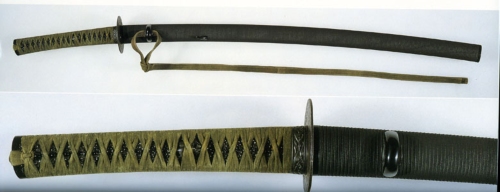
Uti-gatana is a sword similar to a taty, but shorter, adapted for infantry. Its length ranged from 30 to 60 or more centimeters. Like kosi-gatan, he was running behind his belt, with his blade up. Uti-gatana can be considered one of the most successful "old swords", since both on the battlefield and in quiet times he gradually replaced the Tati.

Katana (daito) is the most legendary non-unique sword, neither more nor less. Some people, with good reason, consider katana to be the best sword of all time. A razor-sharp blade was able to cut almost anything - from a silk handkerchief to a heavy gun barrel. American soldiers who fought with Japan during World War II had even a special instruction - in the case of close combat, do not close with swords with rifles, because these same katana rifles were chopped into two neat halves. In addition - the richest traditions, dozens of schools, hundreds and thousands of worked techniques and techniques ... Quite enough to ensure that interest in this sword did not weaken to this day.
Attention is a myth: it was the rolled samurai who performed hara-kiri. First, it is more correct to call samurai ritual suicide seppuku. Harakiri is a "simple version", and its application was a sign of uncouthness and intimacy. Secondly, doing seppuku with the help of katana is very, very uncomfortable. As a rule, a special knife was used for this - or, in the field, wakidzashi.
It is interesting: at the end of the period of the "Old Swords", the term "Tati" was used to refer to any katana suspended on the belt, not plugged into it.
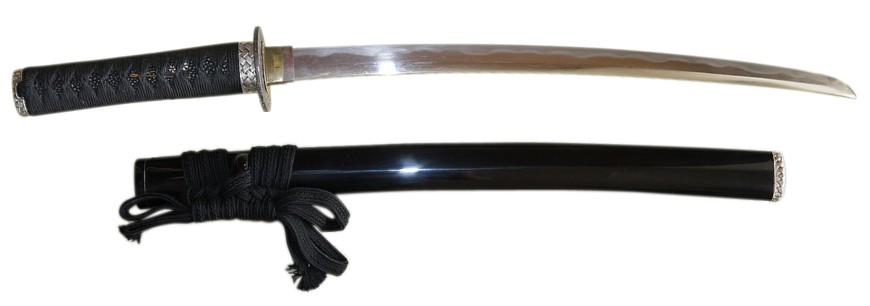
Vakidzashi (setho) - a pair sword to the katana, together with which they formed daisy, a mandatory set of weapons of the samurai. If the katana was the "keeper of life," then vakizashi is the "guardian of honor." With him, the samurai never parted, even in the presence of higher authorities or in the bathhouse. In all, vakizasi was similar to katana - except in size. And it is rather strange that in the battle wakizashi was used very rarely. Only a few schools taught daisyu, including the school of Ni- tan Iti-ryu (School of the One Two Heavens), founded by the famous swordmaster Miyamato Musashi.

Shinobi-gatana (ninja-something) . There is so much written about this sword, forgive, delirium, that it is very difficult to find the truth. A long black sword, straight, rushes on its back ... And it's stuffed with different secret gear, cleaner than all the James Bond cars put together. N-yes, something gave out a spy in Stirlitz. Either a strong-willed posture, or a courageous profile, or a parachute trailing behind him ...
Attention - the myth: the blade of the sword of the ninja was painted in accordance with the traditions of his clan. Not otherwise, then, to make it easier to go to the executing organization, if they catch the Shinobi ...
In fact, the Sinobi-gatana did not differ in appearance from the most ordinary samurai sword corresponding to the task of rank - be it ashigaru or daimyo. The differences were in the details - a stronger tsuba, a longer cord of the sageo, a shorter blade (with a normal scabbard). It's all. No secret knives, retractable blades or similar tricks "from department Q". But the cunning scouts invented more than a dozen different ways of using the sword - for example, when you overcome a wall or move in the dark.
Attention is a myth: the ninjas always wore their swords behind their backs, the hilt on the right. Probably, in order to make it more difficult to remove them from their scabbards or hide them in them. In general, yes, there was a way of carrying the sword behind, but it was rarely used, did not differ in convenience, and there was nothing secret about it. And the handle was located on the left.
New swords (Shinto) / New new swords (syncinto)
The bloody period of civil strife and anarchy ended, and the Shogunate Oda and then the Tokugawa shogunate came to replace. Period of relative peace and intentional preservation of "glorious traditions of the past". Wars mostly moved from battlefields to castles and cities, where opponents deprived each other of lives for a friendly tea party.
The periods of Shinto (1596-1624) and Shinshinto (1624-1876) did not bring anything new to the art of creating a sword. Katana and wakizashi firmly seized the position of the ideal blades, and the convenience and speed of extracting them from the sheath saved and killed many lives. But these periods brought swords to the wide fame of the true works of art - it was then that the unspeakable beauty of the frame and impeccable blades were created. Separate smiths conducted experiments to improve the forging process, which is already turning into a full-fledged mystical ritual ...
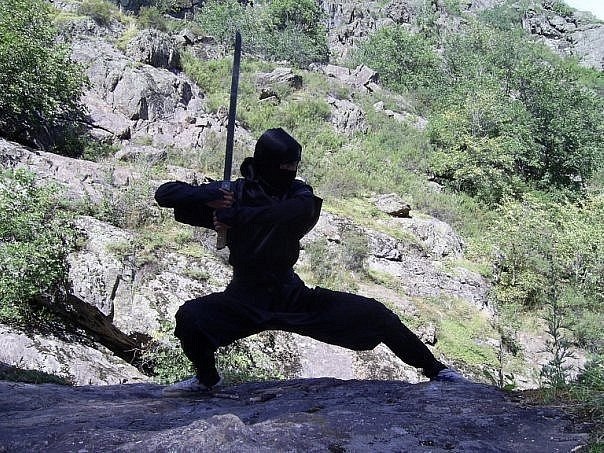
In this relatively peaceful period, there are two parallel processes ... First, the "frost" of the military class. The new government tries in every possible way to restrict freedom of thought among the soldiers, rightly believing that this is dangerous for the stability of the authorities. At the same time, various schools of sword craftsmanship flourish in violent colors. Moreover, judging by the notes of Miyamoto Musashi, most of them are oriented not to the development of art, but to receive quick benefits due to external beauty and spectacular style. The path of the swordsman as a warrior goes to the background.
Gradually, the shinobi are dying out - some of their organizations were destroyed during the formation of the shogunate, some were bought with giblets "at the service of the state." As a result, until the emergence of "black ships" lived only one family of "true shinobi" - the rest have long been turned into ordinary bodyguards.
The newest swords (gendayto)
In 1853, the so-called "black ships" appeared off the coast of Japan. Four American military ships under the command of Matthew Peri delivered an ultimatum, according to which Japan somehow opens for trade - if not voluntarily, then by force. The violent "fixation" of estates and the numerous obstacles that the shogunate repaired with any innovations, played a cruel joke with him - armed with the latest squeak of seventeenth-century military thought, there was simply nothing to oppose to Japan's naval cannons and the army of the nineteenth century. A flood of foreigners poured into the country.
Under the influence of Western ideas in the country began unrest, which the shogunate held back for two centuries. The time left in history as the Bakumatsu period began, and then, in 1868, the shogun completely renounced power in favor of the emperor, and the restoration of Maiji began - the rapid "Europeanization" of Japan. The feudal system was abolished, industry was born, the class division of the people disappeared ... And the army changed. Now the main role on the battlefield is already completely played by firearms. Traditional swords were replaced by European swords ... But not entirely.
In 1883, the style of officers' swords, called kyugunto, was officially approved. These swords were made in the style of European sabers and differed from them only in the form of a blade. It was also allowed to transfer to the kyuguntu frame the blades of old family swords of earlier periods. It was such swords that Japanese officers fought in close combat in the Russian-Japanese war.
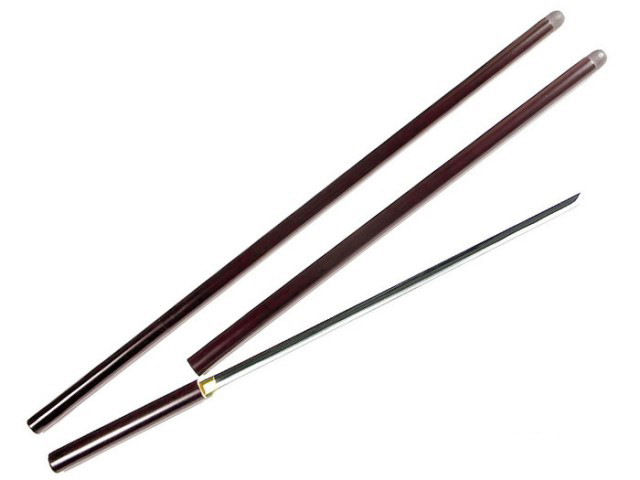
And in the 1930s, there was a pullback. A sharp leap of patriotism and nationalism led to the introduction of excuses such as the Singguinto and the Kaigunto. At the peak of their predecessors, these swords were created on the basis of the classical sword of the Tati - with all its attributes.
Noteworthy is the version of the sword of sikomi-zue, also known as the sword-cane: a straight, thin blade of low quality, disguised as a bamboo stick or an old cane. Most of these swords were created in the Maiji era.
Kenjutsu and Iaijutsu
Since we have touched on the subject of Japanese swords, let's talk about Japanese fencing. It existed in two main formats - kenjutsu and iaijutsu.
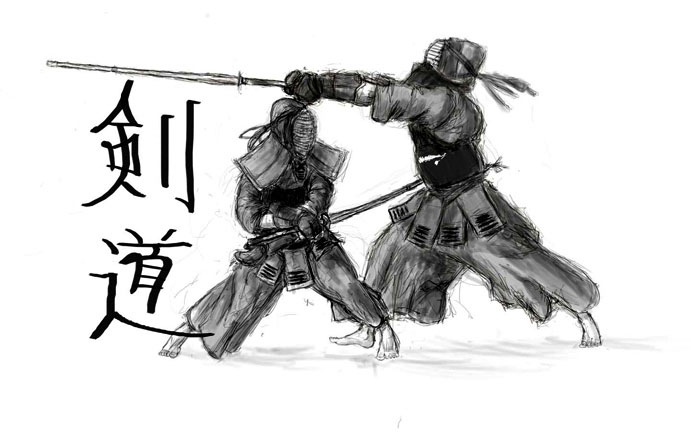
Attention is a myth: the samurai had the right to attack only in a rigidly set "set" of directions, only face to face and only on specific parts of the body - otherwise the attack was considered dishonest with all the consequences. This statement in no way corresponds to the truth - as the written instructions that survived to the present day, the samurai had the right to attack the enemy in any convenient way, including from the back. In the course there were also painful techniques, kicks, shots of brilliant objects for distraction. A little bit more realistic is the myth that the samurai always exchanged names before the battle and fought alone. This custom really existed - until the first Mongol invasion. Subsequently, the tradition has survived only as part of the "duel code."
Literally kenjutsu is translated as "art of the sword" - and, like any art, it had many schools and styles. Most of the techniques were focused on the speed and accuracy of the blows - an easy and sharp blade contributed to this approach. The school included not only physical techniques (called kata), but also spiritual preparation (primarily Zen Buddhist teachings), as well as many additional disciplines, the list of which varied from school to school. Great role was given to control and concentration of internal energy, control of emotions ... For example, according to numerous evidences, the sword masters were able to foresee in some way events or change the state of their bodies in a variety of ways - making it hard or light, hard or soft ... However, the mystical approach is typical for almost all Japanese martial arts.

This is interesting: it is possible that it was these images inspired by George Lucas, creating the great Jedi Order - a community of warriors and sages. Too much in the ethics of light Jedi in common with the ethics of Zen Buddhism ... Yes, and Obi-Wan, according to the initial idea, was to play the Japanese.
In addition, the Japanese fencing technique did everything in its power to avoid "hard blocks" - it could easily lead to breakage or damage of the parrying blade ... And some schools (including the already named Ni-teng Iti-ryu) and did develop techniques to disarm the enemy through destruction Sword.
Similarly, Miyamoto Musashi emerged from a difficult situation. Once he was called to fight daimyo Matsudaira, considered an excellent warrior. According to the laws of that time, Musashi did not even have the right to injure such a high-ranking samurai - for this he was expecting an imminent death. Therefore, he was his boken (at a certain stage he refused to use a combat sword in dueling, preferring a wooden training) broke the daimyo's sword in half, thereby forcing him to admit defeat.
Iajutsu is "the art of exposing a sword", more precisely, the art of striking with a sword directly from its scabbard. Initially, it was part of kenjutsu, but then it was separated into a separate discipline. And it also created a lot of disputes among specialists about the ethics of this art. On the one hand, such an attack meant suddenness, that is, attack of a non-ready opponent, on the other hand, the samurai had to be ready to attack at any time of the day or night. Personally, I think the second position is more convincing.
Currently, Japanese fencing is experiencing a decline associated with its transformation into sports and spectacle - the strictest regulations and restrictions lead to the oblivion of ancient traditions. Compare the ancient kenjutsu and modern kendo - it's like comparing the winter defense of Moscow with the biathlon championship.
Japanese swords are a huge layer of traditions, culture and craftsmanship, every blade is a unique work of art ... But like knights and pirates, they went into circulation and turned into an "entourage sword", creating hundreds of "like samurai" and legions " American ninjas ". And also numerous swindlers, "the last heirs of the disappeared traditions." Noble weapons, the most perfect blade on Earth, turned into a frank cliche and consumer goods, which pop wherever you get. What for? That was. Because it's fashionable ...
It remains to hope only that it will soon pass. In firms dealing with games and films, there will be more people who are not interested in mockery of another's cultural heritage and have a sense of proportion ...
Author of the article: Tanaka Kensin, for the magazine "Best Computer Games"



Comments
Commenting on, remember that the content and tone of your message can hurt the feelings of real people, show respect and tolerance to your interlocutors even if you do not share their opinion, your behavior in the conditions of freedom of expression and anonymity provided by the Internet, changes Not only virtual, but also the real world. All comments are hidden from the index, spam is controlled.